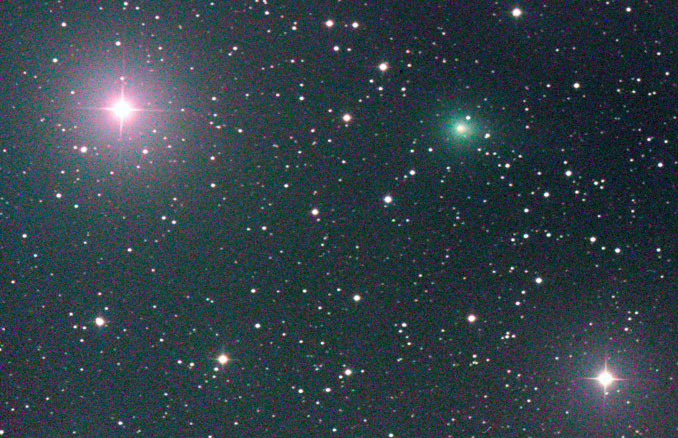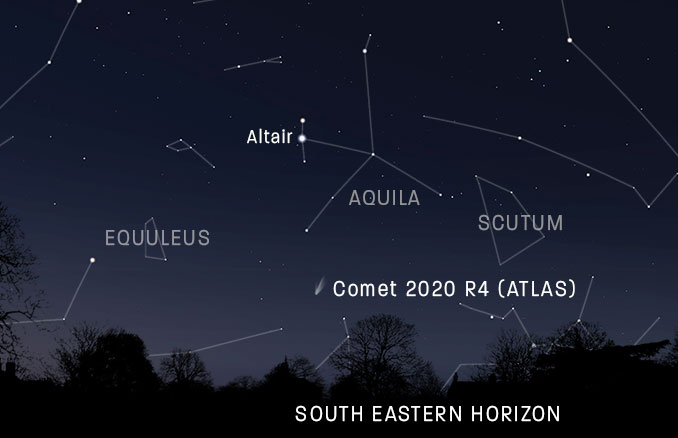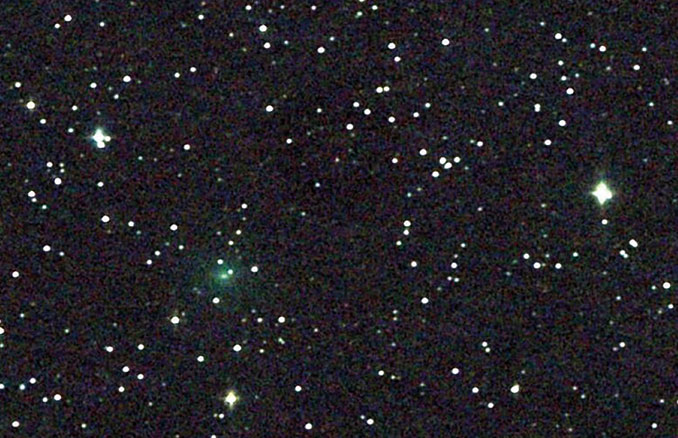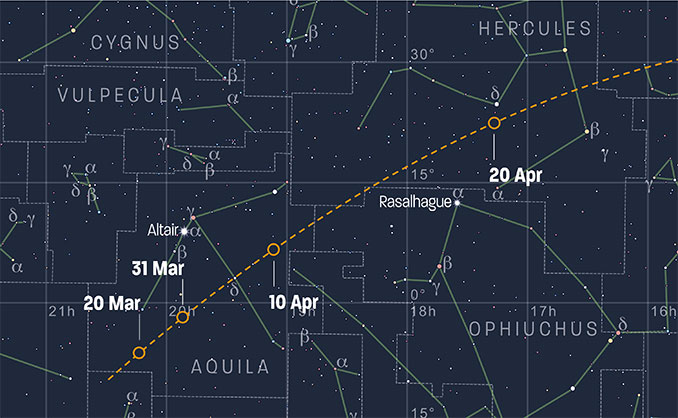
Long-period comet 2020 R4 (ATLAS) is gracing our predawn skies this week and is well-worth a look through a pair of binoculars or a small telescope. It is the best cometary prospect visible from mid-northern latitudes right now and is all set to end the hiatus in relatively bright icy visitors since we were all thrilled by comet 2020 F3 (NEOWISE) last summer. Although 2020 R4 (ATLAS) is not predicted to put on anything like such a spectacular show as that great comet, it’ll be well-worth a look through a pair of binoculars or a small telescope. Experience has shown that where comets are concerned, one has to gratefully accept what’s on offer while awaiting the next big one!
Long-period comet 2020 R4 (ATLAS) was a nineteenth-magnitude discovery on 12 September 2020 by the ATLAS (Asteroid Terrestrial-impact Last Alert System) team, operated by the University of Hawaii’s Institute for Astronomy using the 0.5m Schmidt telescope at Mauna Loa (ATLAS-MLO) on Hawaii. After surviving perihelion passage (closest approach to the Sun) on 1 March, when 2020 R4 (ATLAS) passed by our star at a distance of around 154 million kilometres (95 million miles), or 1.03 astronomical units (AU), the comet has just emerged into the UK pre-dawn sky as a lowly target for a pair of 10×50 binoculars. The most recent estimate of its brightness (13 March) have it shining at around magnitude +8.4, with a well-condensed coma.

You’ll need to rise early from that warm bed to catch comet 2020 R4 (ATLAS) this week. On the pre-dawn of Tuesday 16 March, it rises shortly before 3.30am GMT from London and climbs to an altitude of around 13 degrees by 5am (about 70 minutes before sunrise), by which time the sky is noticeably lighter with the onset of nautical twilight (when the Sun is between 12 and 6 degrees below the horizon. The comet is located in the far south-eastern reaches of Aquila, the Eagle, which is a prime constellation of the late-summer sky. Sweep south and slightly east of the magnitude +3.2 star theta (θ) Aquilae; comet 2020 R4 (ATLAS) lies around eight degrees (about one-and-a-half 10×50 binocular fields) south-south-east of the star.
You’ll need to secure an observing site with an advantageous vista over the east-south-eastern to south-eastern horizon (azimuth around 120 degrees), though it won’t be an easy task to spot the diffuse comet in a brightening sky and at low altitude. The closer to the horizon your chosen object lies, the more of the atmosphere you are looking through and the more your view deteriorates and the perceived brightness of the object decreases. However, as March wears on, comet 2020 R4 (ATLAS) makes steady progress away from the horizon for the same degree of twilight. Also, the Moon is only just past new phase and so it won’t interfere with pre-dawn observations until the end of the month.

By the morning of 20 March, comet 2020 R4 (ATLAS) will have climbed northwards and westwards to lie at an altitude of almost 16 degrees by 4.50am GMT (onset of nautical twilight from London). The comet is now located midway between theta Aquilae and magnitude +3.6 Algedi (alpha2 [α2] Capricorni), stars that lie around 12 degrees apart.
According to the light-curve of comet 2020 R4’s (ATLAS’) estimated brightening, it appears to be about a month away from hitting its peak magnitude. An ephemeris from the Minor Planet Center (https://www.minorplanetcenter.net/iau/MPEph/MPEph.html) has the comet at a much fainter magnitude (it has already far exceeded original brightness estimates), but shows the comet is predicted to brighten by over a magnitude to be at its best between 20 and 25 April, around the time it is at its closest; on 23 April, comet 2020 R4 (ATLAS) passes 69 million kilometres (42 million miles), or 0.46 AU, from us.

During late March and the first three weeks of April, the comet shows an ever-increasing motion across the sky. By the end of March, it lies at an altitude of around 25 degrees from London by the beginning of nautical twilight at about 5.20am BST (04:20 UT). It is then around three degrees south of magnitude +3.9 eta (η) Aquilae.
By the time of closest approach to Earth on 23 April comet 2020 R4 (ATLAS) has transferred into the evening sky, having rocketed through Aquila and southern Hercules. It rises at about 6pm BST (17:00 UT) among the stars of Corona Borealis and climbs to an elevation of almost 30 degrees in the eastern sky by the end of nautical twilight at about 9.30pm. It then crosses the southern meridian (culminates) at about 3am BST (02:00 UT), achieving the dizzy heights of close to 70 degrees altitude!
